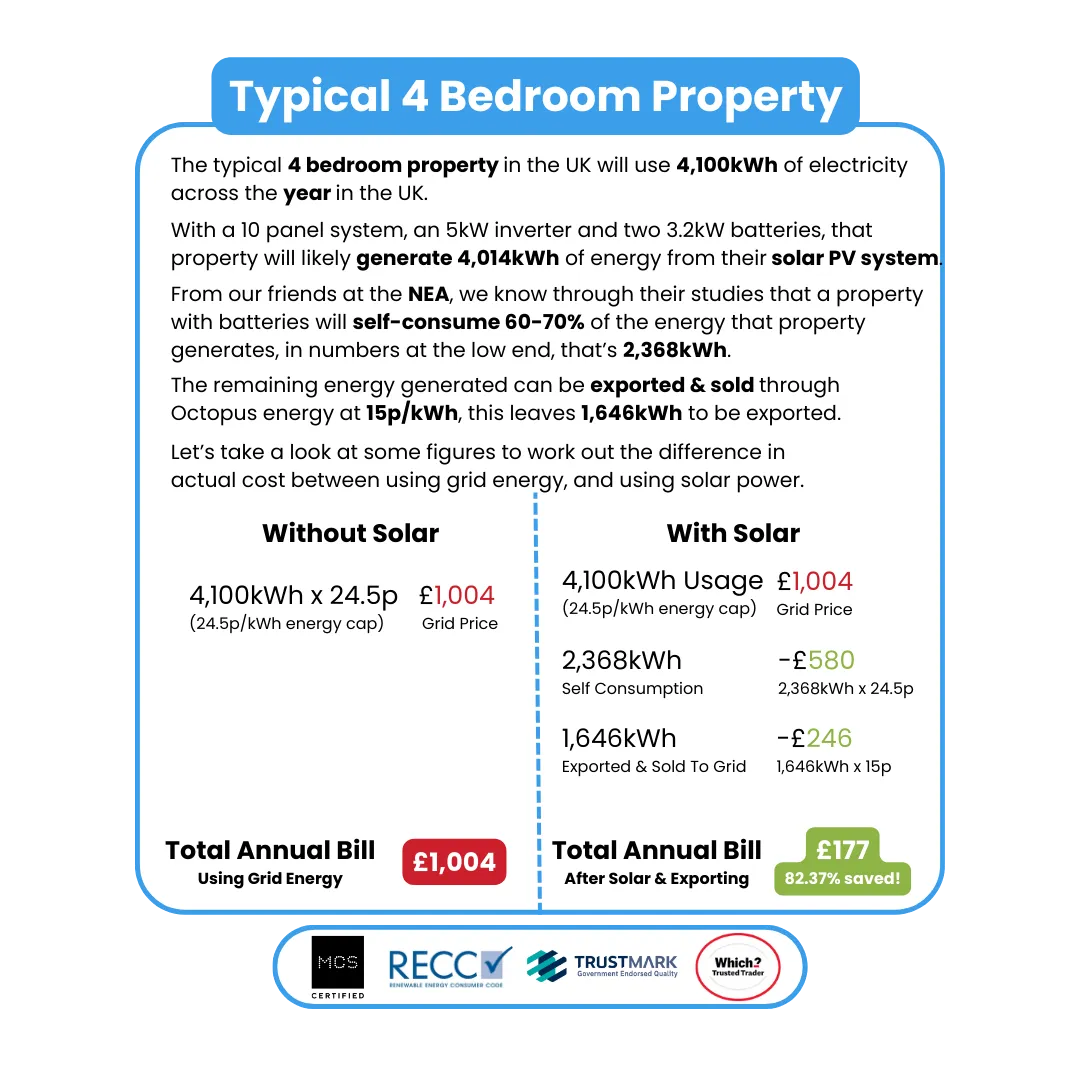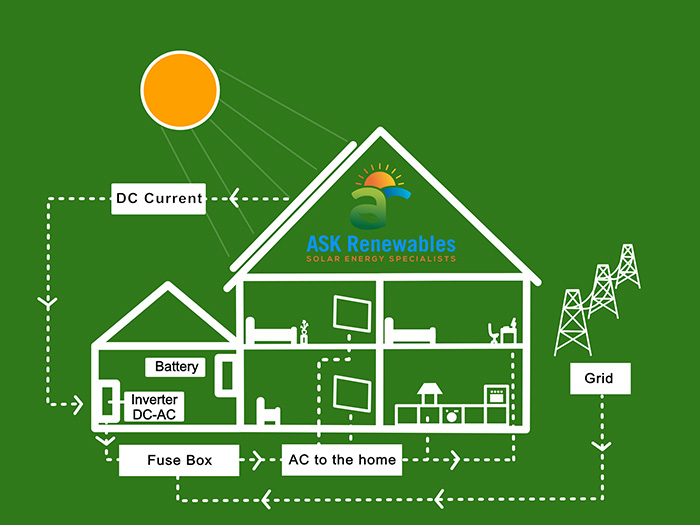

Wondering what solar pV would cost for your property?
We know that people want to understand clear and straightforward pricing for installing Solar PV. So, we’ve pulled some system pricing examples from our price list…With some information from you regarding your home we can show you some realistic options for a solar PV and storage system, installed, commissioned and certified.
Over 150+ Verifiable reviews on which?

Here's A Real World Example Of How We Could Help Lower Energy Costs By 82.4%!

No ifs, no buts, no maybes. Just
cold hard facts, all data on this page is produced by either Ofgem, the NEA or an MCS accredited software for understanding the variables when it comes to Solar PV - with sources below! If you want all the juicy details, including calculations and the supply & fit costs of solar PV scroll through this whole page.
We only ever use figures from reputable sources...



Here we go... here's the breakdown of how we save you money using a state-of-the-art Solar PV System.
starting with all the data
Facts, Figures & Variables
Average usage of electricity in a 4 bed property across the UK - 4,100kWh/year. Source: Ofgem.
Self consumption of energy generated using battery storage - 60-70%. Source: National Energy Action.
Generation figures & system specs: 10 x 450W AIKO panels, two 3.2kWh Hanchu batteries, 5kW LUX Power Inverter. Source: PaperClip MCS accredited software.
Predicted unit cost per kWh of energy from the grid: Starts at 24.50p, increasing with inflation. Source: Ofgem price cap.
Export price for energy sold back to the grid: Starts at 15p, increasing with inflation. Source: Octopus Energy.
Ready to figure out how to save money?
Let's get on with the calculations...
If you were buying 4,100kWh of energy from the grid at 24.5p/kWh, it would cost you £1,004/year at the current rate.
With a 10 panel system as specified in the "Facts, Figures & Variables" section, we know that based on our calculations using PaperClip that on a perfectly south facing property, with the panels at a pitch of 35 degrees and minimal shading in the WF4 postal code area that system will generate 4,014kWh/year.
We assume that based on the 60-70% figure from the NEA in terms of self-consumption of energy, that will give the property owner 2,368kWh of self-consumed energy against their usage of 4,100kWh/year. Based on the current energy price of 24.5p/kWh, this is equivalent to £580.
We then dictate that the remainder of the generated energy is exported at 15p/kWh, the remainder being 1,646kWh of energy. This totals £246 exported in the first year.
Using these figures, we know that you're self-consuming £580 worth of energy, and exporting an additional £246 worth of energy. This totals £826.
When you compare this against the £1,004/year cost of energy at the current rate, and subtract your £826 of solar energy it leaves you with £177/year in electricity costs.
So, how long would it take to generate a return on my investment?
So, we know that this property is using roughly 4,100kWh of energy every year, starting from this year at 24.5p/kWh we've calculated all costings using inflation at 2%, and energy cost inflation at 6%. That means that over 20 years, this property will pay £37,951.13 in energy costs using grid energy.
For this exact specification of system we've used here, we would charge £7,300 supplied and fitted. That means that in just 7 years, your system is generating you a return on your investment and more importantly, stabilising your energy bills for the next 20 years.
When we run the same calculation using the solar PV system, we expect that your costs will be £11,060.13 across the next 20 years. A whopping £25,891 less than if you were to continue relying on grid energy.
For an investment of £7,300 - you'll get £25,891 back leaving you £18,591 in profit over 20 years!
If you're ready to start exploring how solar PV can work for you, our friendly team will put together a document with your savings in plain English showing you over the next 20 years what your costs will be both with solar panels, and without solar panels. Book a no obligation, 15-minute Q&A call with our friendly team below and get started today!
here's what matters to us
We're obsessed with putting customer service above everything else.
Our 150+ Which? Trusted Trader reviews show our customer service score at a 5.0 across every single one of our 150+ reviews, that's what really differentiates us from our competitors. When that many people love our service, we know you will too!
Family run business.
From our family to yours, complete no nonsense solar PV knowledge.
Customer service above all.
Our 150+ Which? Trusted Trader reviews give us constant 5 stars!
Modern system delivery, with no fluff.
Straight talking experts in modern system delivery.

Here's what matters to us
We're obsessed with putting customer service above everything else.
Our 140+ Which? Trusted Trader reviews show our customer service score at a 5.0 across every single one of our 140 reviews, that's what really differentiates us from our competitors. When that many people love our service, we know you will too!

Family run business.
From our family to yours, complete no nonsense solar PV knowledge.
Customer service above all.
Our 140+ Which? Trusted Trader reviews give us constant 5 stars!
Modern system delivery, with no fluff.
Straight talking experts in modern system delivery.
Here's what our customers say about us...
which? trusted trader Testimonials

testimonials

Frequently Asked Questions
Do solar panels typically need planning consent?
In most cases, solar panels fall under permitted development so you do not need to make aplanning application. There are exceptions, if you live in a listed building, an area ofoutstanding natural beauty, a conservation area or a World Heritage site you may needplanning consent, you should make these enquiries before agreeing to an installation.
How long do solar panels last?
Solar panels are designed for durability and longevity, with top-tier, monocrystalline solar panels often coming with manufacturer warranties that guarantee their product for 15 to 20 years or more. This assurance reflects the robustness of solar panels, which, thanks to having no moving parts, are remarkably long lasting.
However, it is natural for solar panels to experience a slight decrease in efficiency over their lifespan. An exemplary testament to the durability of solar panels is a PV system installed by the SUPSI PV Lab in Switzerland in 1982, which remains operational and continues to generate electricity effectively to this day. For more insights into their long-standing research and achievements in solar energy, visit SUPSI PV Lab.
When investing in a solar PV system, consider it a commitment of at least twenty years. During this period, it’s likely that the inverter, a key component of the system, will need to be replaced to maintain optimal functionality and efficiency.
Can solar panels still generate power on cloudy days?
Absolutely, solar panels are capable of generating power even on cloudy and rainy days, though their efficiency may not reach peak levels experienced under direct sunlight. The effectiveness of solar panels under such conditions varies with the density of the cloud coverage. Clouds, fog, and even shade from surrounding trees can diminish the intensity of sunlight reaching the panels, consequently reducing their output.
Despite these reductions in efficiency, it’s important to note that solar panels do not cease operation in the absence of direct sunlight. They continue to produce electricity, albeit at reduced levels, by capturing diffused sunlight that penetrates through the clouds. This capability ensures that solar panels can contribute to your home’s energy needs across a variety of weather conditions, enhancing the overall viability and sustainability of solar energy as a reliable power source.
What maintenance is required for solar panels?
Solar panels are renowned for their durability and low maintenance requirements, primarily because they lack moving parts and therefore are extremely reliable. However, it’s important to acknowledge that solar panels can experience a slight reduction in efficiency over time. This degradation is gradual and can be mitigated to some extent by occasional cleaning, particularly if your home is in a coastal area or a location with high levels of dust and traffic pollution. Such environments can lead to the accumulation of residues on the panels, which may affect their performance.
It’s advisable to view your solar PV system as a long-term investment, ideally over a twenty-year horizon. Within this period, one key component that you may need to budget to replace in order to maintain the system’s efficiency and reliability is the inverter. Planning for the eventual replacement of the inverter ensures that your solar energy system continues to operate effectively, providing sustainable energy to your home while minimising the need for extensive maintenance.
Ready to own your energy generation
and cut your electricity bills?